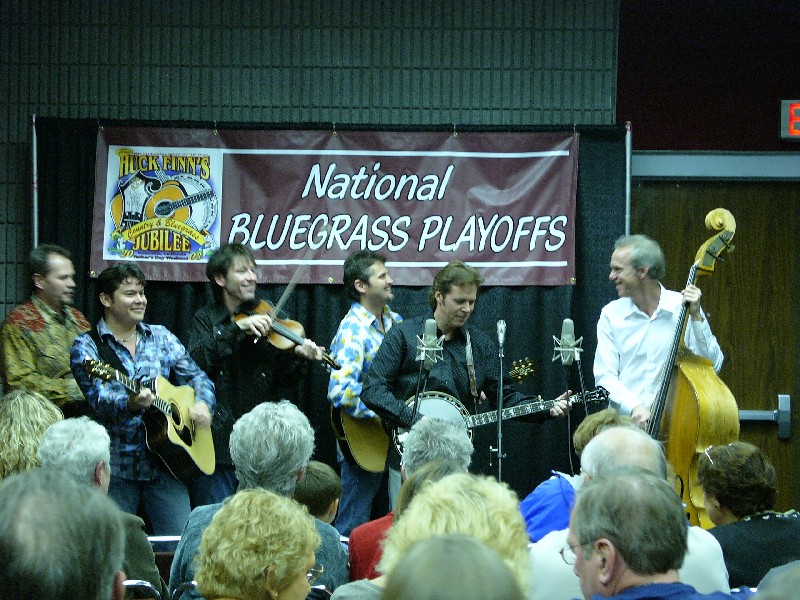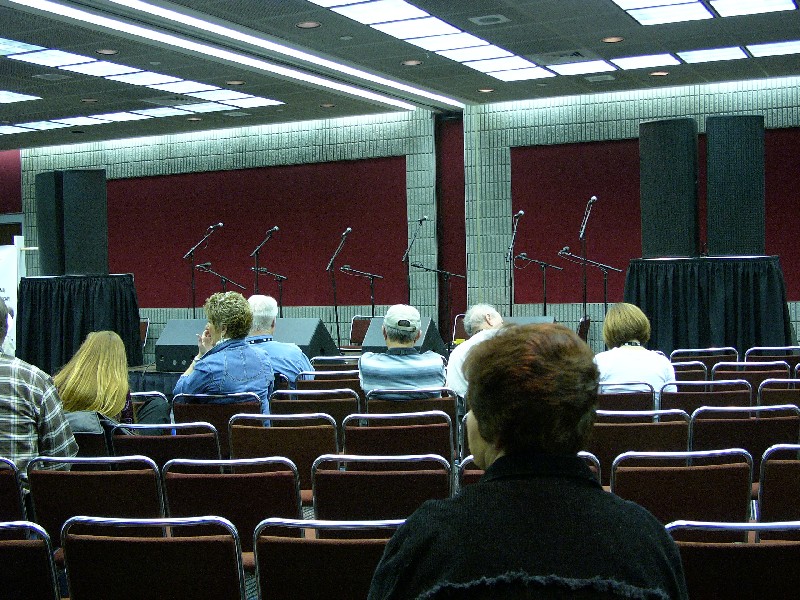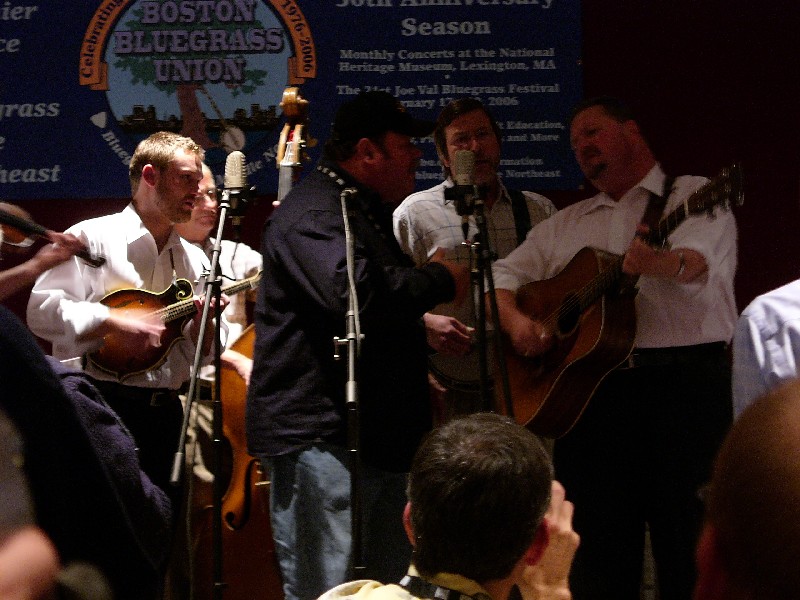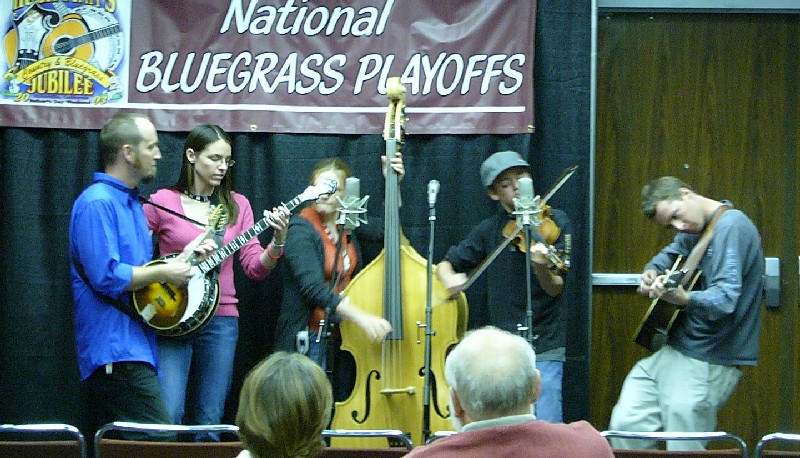International Bluegrass Musicians Association
|
This article is an editorial and expresses the opinion and experience of the author. Please post comments in the discussion page.
|
|
This is a report from the IBMA - International Bluegrass Musicians Association - October 26 2005]. This chronicles the results of using the L1™ Traditional Music System. Submitted by:
This originally appeared in the Bose Community Message Boards. IBMA -- Int'l Bluegrass Musicians Assoc. -- update |
Introduction - Steve-at-Bose
Hey gang,
Steve here. Tired, happy, tired and ... ummmmm .... tired.
I'm at the IBMA event in Nashville, TN, USA and thing are really cooking. Thanks to an invite from bluegrass lover, Rich Stillman, we decided to come down and see what's happening with the system and the Bluegrass folks. With Rich's help we outfitted a few "showcase rooms" with systems and decided to see how thing would work out.
I'll let Rich (Stillman) cover the "how we set it up" stuff in detail, but basically we've set up two microphones (each going to a system) a couple feet apart for doing these showcases. Now if you've never been to one of these read then next paragraph, otherwise skip one.
Here's what happens at a showcase event. A room is run by a venue, or an association or a manufacturer, and bands or individual artists come in and play a 20~25 minute set. Then, you've got 5 minutes until the next band is on. It is rapid fire and very interesting to observe (and stressful to work).
We've had to L1 Cylindrical Radiator® loudspeaker set up in a few rooms and I've got to say I'm pleasantly surprised at how well they are working. Last night I left one of the Bose powered rooms and wandered. I wanted to see if we were better than other rooms (sound quality wise) or about even or worse. I quickly found out why the Bluegrass musicians were flipping out over the Bose sound.
The easiest way to describe what I heard was this. It sounded like there was no amplification ... until someone walked away from the microphones and spoke. Amazing. Even I was surprised at how well our little speaker sounded.
With Bluegrass they are far more concerned with quality of sound over volume. I had one room that during setup the host said, "let's turn down" and I (the dumb rock/blues guy) thought, wow, this isn't even loud yet. Then I went to speak and realized that my voice was quite loud. We had a nice level for about 50~75 folks to enjoy the music without being blown away.
I've got to share that the feedback from listeners and musicians has been shocking. They see "Bose Corporation" on my badge and start gushing. Great complements and great questions: "How does it do it?" "I can't believe how good it sounds." "Yey, I love that new speaker of yours."
It's been a fun trip so far and I'm gearing up for my third late shift. The running joke is IBMA means I've Been Mostly Awake. Sleep is a rare commodity.
Oh, no. I've gotta fly. sorry for the quick post. More to come. Ken's here today and he was smart enough to bring a camera. More to come.
For those in the Bluegrass community we're planning on doing a trial with Rhonda Vincent tonight at 10:30 in room 207 ... shhhhhh ... Wink if you're nearby come on by and I'll let you in.
I guess she heard the systems last night and said something like, "That sounds fantastic. Can I bring the band in for a trial." We said "yes, of course." We're excited to hear her try the systems out.
Gotta fly, Steve
Introduction - Ken-at-Bose
Hi Everyone,
I just got into Nashville yesterday and the place was already SMOKIN'. There's about 2500 professional bluegrass players here and as you can imagine, all heck is breaking loose. These are the big boys and girls, and the fabulous assortment of up and coming acts.
This music is totally happening and totally alive. There's tons of musicians of all ages here and you can easily see the next gen coming up through the ranks.
It's a total blast to be able to hear well, and really appreciate the cookin' string licks and fabulous vocals.
I was very pleased with the performance of our Traditional Music configuration of two wide-area condenser microphones, each connected to one L1 Cylindrical Radiator® loudspeaker pushed downstage and to the side. As a reminder of the technical details of our new setup see: L1™ Traditional Music System
The rooms could hold about 100 people each, and most performances were stuffed to the rafters.
What's utterly wonderful about the new configuration we worked out is that it's a walk on and play solution for the groups. There's nothing for them to plug in. This creates a beautiful and relaxed environment.
Players use a kind of choreography already worked out for single mic technique commonly used in this genre. When it's your turn to solo, your bandmates make room for you to move in on the mic. Our new system makes it possible for this to be much more relaxed because there's two mics, although the main reason for the two mics to have glorious spatiality to the music out in the audience (the acoustic ensemble on stage gets this "for free".)
I'll post a few photos from last night (late late late) with apologies for the moment in not being able to name the bands (if I were anybody, I'd know instantly who they are as they're all touring pros.)
Pictorial Report - Ken-at-Bose
Here's a picture of how a lot of bands are set up for showcases. There were LOTS of problems with this system last night. Guess what was the biggest? Yup, you got it, feedback. Ear splitting and lots of different frequencies. It was very hard for the musicians to relax.
Here's one of the groups (The Grasscals) that played on our new system. These guys TOTALLY ROCKED. Killer players. Many are multi-time champions in their instruments.
 Here's another group on the system. Note the "dummy mic" in the center. This was used to give the players a familiar target while they got used to the dual mic system.
Here's another group on the system. Note the "dummy mic" in the center. This was used to give the players a familiar target while they got used to the dual mic system.
As you can see, the tightness this new approach allows is real back-porch stuff. This is the way these guys learned how to play and love to play and this system allows them to play that way. It's totally lovely and naturalistic. Look at the expression on the guitar/vocalist's face. That's the deep living structure of live music performance. There ain't nothin better.
I add this shot because it shows you one of the young up and coming professional bands. The fiddle player was about 11 years old and the others were in their early twenties I'd guess.
Look at the guitar player on the right. Again, here you see the bottomless power of music. These guys and gals were totally down into the thing. You could have seen some of this stuff from space, that's how big an energy field was being created.
Report - Rich Stillman
Hi all, I asked Ken to wait for me to post the gory details of how everything went together at IBMA.
We did a total of eight showcases in five rooms that hosted 42 sets of music over three nights, and the sound and mixes were consistently good. Audiences didn’t really know what hit them, but they liked it! After all this experimentation, we’ve reached a point where we can get consistently good sound, although there are still some issues we need to smooth out. More on those later – first, an explanation of what we did.
You can see pictures of the setup, as well as a number of bands playing into it, at http://www.waystation.net/PAS-IBMA
The Setup
Our preferred setup used two PAS units. In the small showcase rooms, which seated about 70, we positioned them close to the side walls, and in the large room that held 250 we put them about 15 feet from the centerline of the stage. The systems were positioned in line with the mics so they were as far as possible outside the sound field being put out by the speakers. This was done to maximize gain before feedback. It also meant the band didn’t get much sound from the speakers, but the close grouping of the musicians and the return from the live room gave the performers enough to go by. No one complained about insufficient monitor, even though we weren’t giving the band any monitor at all!
Our microphones were Shure KSM27s, lent to the project by Shure. Actually, most of the mics were KSM44s, but we ran them with the second diaphragm turned off so they behaved more or less like 27s. Each mic was directly cabled to one of the PAS bases, effectively giving us two completely independent sound systems. This allowed us to put the mics wherever we wanted without worrying about phase cancellation.
When we did our final pre-IBMA testing in the Bose theater, we took precise measurements of the placement of mics. In Nashville, we found that precision completely unnecessary. We started with the mics about 30 inches on either side of the centerline, and shifted them as the band sound checked to get the best possible sound and stereo separation. In most cases the mics ended up about two feet away from center, but there was nothing hard and fast about that.
Because the bands were new to this setup (as were we), we placed a third microphone on center as a visual reference, but we didn’t actually connect it to anything. We instructed the bands to treat the center mic as if it was the only one on stage, and ignore the live KSMs on either side. For the most part, they found themselves doing that instinctively, the lead vocalists working the center mic as if it was an SM57 and doing the ensemble singing and playing at a respectful distance from the whole cluster of mics (one musician commented that it looked like a press conference). The only reason I can imagine that everyone just fell into the habit of using the system right was that they heard the best results there. We certainly did.
One of our early discoveries was that aiming these mics straight at the back wall gave us a dead spot right in the center, where the lead singer was standing. The solution was to rotate the KSMs toward the center so the lead was singing on-axis to both mics. This worked so well we could use the mic angle as a volume control for the lead voice, and from that point on part of the sound check involved singing into the center mic and turning the KSMs to get the best gain from the lead voice. We ended up with the KSMs toed in from 45 to 60 degrees. The center dummy mic became a very important part of the setup at that point, although a band using this configuration full-time wouldn’t need it for long.
Results
The results we got through the system were amazing. The first piece of good news was that the even distribution of sound around the room allowed us to run the systems at much lower gain, giving the bands a far more balanced sound everywhere in the room. The separation of the two microphones, magnified by the distance between the speakers, gave us a stereo image. The stereo effect wasn’t overwhelming – because most sound sources were picked up by both mics, it didn’t sound like a headphone mix. But all that was needed to make the effect obvious was to listen with your eyes closed. As one audience member said, “it sets the stage”.
I think the stereo separation was responsible for one of the biggest benefits of the configuration, the even vocal blends. With singers all over the mic patterns, it seemed like some voices should dominate the mixes, but it didn’t happen that way. Band after band, the vocals sounded like a CD-quality mix. After a while, I started thinking that the stereo separation was responsible for that. Since each voice came from a different direction, listeners could use the “cocktail party effect” to focus on the voices they wanted to hear. Effectively, if I like a level mix and you like to hear the lead a little louder, we should each be able to hear the mix we want from the same performance. I have no evidence for this, but it would be easy enough to ask the audience what they heard after a performance, and see if their descriptions differ.
Unusual Configurations
We had a couple of variations on the theme during the week. One showcase presenter hosted five bands using a traditional multi-mic setup, connecting the PAS systems to their mixing board and sending a separate monitor mix through standard floor monitors. The engineer in that room had problems with gain before feedback until he turned off the monitors entirely. Once that was done, everything worked fine.
Our second odd setup involved adding a separate mic for Michael Cleveland, two-time IBMA fiddle player of the year, who sat in with a showcase band playing mandolin. Michael is blind and needed to stand still in front of a microphone. We activated the dummy SM57 from the center, moving it to the side. Mike’s mandolin was coming entirely from one side of the stage, but that’s where he was standing so it didn’t sound odd at all. However, without the center mic to focus on, the band’s lead singer began singing directly into one of the KSMs. The lead singing very obviously came from one side of the stage, and the extreme separation of the voices made their blends difficult to listen to.
One band that hosted their own afternoon showcase had an unusual setup: three seated musicians, two playing through amps, and a standing fiddler/singer. To get everything heard, we used an extra dynamic mic aimed at the unamplified singer/guitarist/banjo player. The two KSMs were quite far away from the other seated singers and their amps, but by aiming those mics differently we got a balanced sound out into the room.
Problems We Encountered
Even though things went very well, there are still some problems to solve. The major one is gain before feedback – while we didn’t have problems delivering enough level to the audience, even in the 250 seat showroom, we didn’t have much headroom. That would be an issue in situations where a band needs to deal with ambient noise, larger venues or outdoor shows. Part of this was due to the equalization – we were running with preset 00 or 01, which ignored the characteristics of the KSM microphones. A custom preset designed for these mics should help tone down the frequencies that feed back first. The choice of mic may offer some room for improvement – maybe another mic, from Shure or another company, may offer better off-axis rejection and tone down feedback. However, the off-axis sensitivity of the KSM27 was one of the reasons this configuration was able to pick up musicians playing and singing over such a wide area, so there are tradeoffs to be considered here.
A second issue was the difference in vocal power of the lead singers. Most bluegrass lead singers can belt out a tune, and they sounded great. Some, particularly those who sing one or two songs per set, don’t have as much volume. In a normal mic arrangement, those singers can just get closer to a mic or turn up the gain. In this setup, they can’t. As one of the presenters said, “you can really tell who the good bands are”.
A third issue resulted from the configuration of most of the showcase rooms. Bands were playing on the same level as the audience, with no risers. When the rooms were crowded, people sitting behind the first few rows heard slightly muffled sound because they didn’t have a clear line-of-sight to the speakers that were at their eye level. For these people, standing up produced noticeably better sound.
-Rich
Rich continues his report here: http://www.waystation.net/PAS-IBMA



